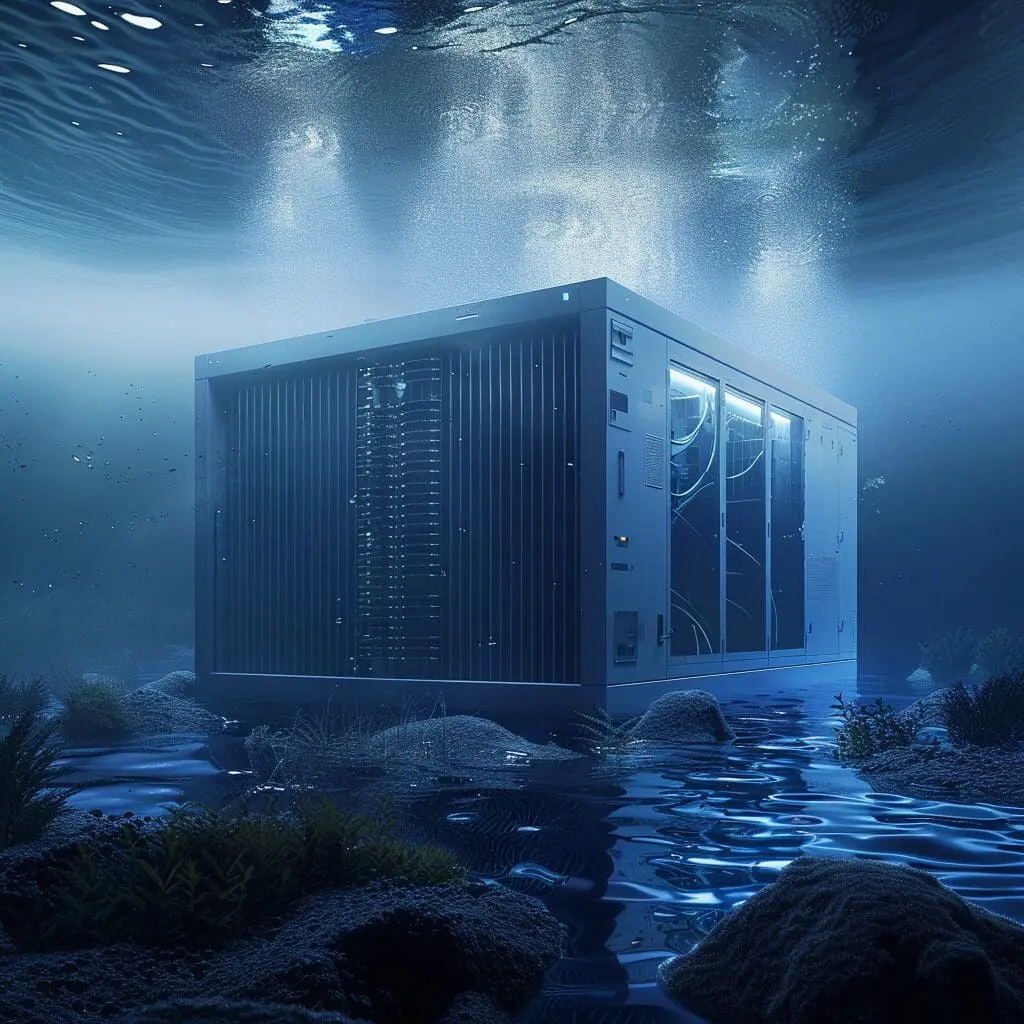
Revolutionising Data Storage: The Rise of Underwater Data Centres

The Power of the Deep: How Underwater Data-Storage is Revolutionising Our Future
The burgeoning demand for data storage has led to innovative solutions, and one of the most promising is the underwater server. Using the natural cooling properties of oceanic depths, underwater data centres represent an eco-friendly and cost-efficient alternative to traditional land-based centres. This approach not only drastically cuts down on energy requirements and lowers carbon emissions but also opens up new avenues for renewable energy and sustainable technology development. Commercial underwater data centres have the potential to revolutionise the industry, yet their success hinges on addressing vulnerability to disruptive underwater soundwaves. Recent advancements in machine learning have introduced sophisticated algorithms capable of detecting and mitigating damage from acoustic disturbances, thereby fortifying the integrity of underwater servers. As we continue to navigate the complexities of digital storage, this marriage of oceanic and technological resources heralds a paradigm shift, paving the way for a future where data storage is both environmentally responsible and secure.
Uncovering the Hidden Threat: The Surprising Vulnerability of Submerged Servers
While submerged servers offer numerous advantages, such as reduced energy consumption and lower carbon emissions, they come with unique challenges. One unexpected threat to commercial underwater data centres arises from underwater soundwaves. These soundwaves, generated by marine life, submarine sonar systems, and potentially malicious actors, can seriously damage the delicate infrastructure when deploying underwater data centres. Studies by leading cybersecurity and robotics researchers have highlighted this vulnerability, showing the potential for severe disruptions and costly damages. Fortunately, advancements in machine learning have led to innovative algorithms designed to detect and mitigate the impact of these acoustic disturbances. This progress is crucial for ensuring the long-term viability and security of projects like Project Natick, allowing them to fulfil their promise of being a sustainable and cost-effective solution for data storage in regions where much of the world’s population lives.
From Ocean to Server: Exploring the Eco-Friendly Benefits of Underwater Data Centres
Underwater data centres represent a groundbreaking step towards sustainable technology, leveraging the cooling capabilities of the ocean to provide an eco-friendly alternative to traditional land-based data centres. By utilising the natural thermal properties of deep ocean waters, these submerged servers significantly reduce the need for energy-intensive cooling systems, thereby lowering overall energy consumption and drastically cutting carbon emissions. The European Marine Energy Centre plays a pivotal role in advancing this technology by integrating marine renewable energy sources to power these data centres. This innovative approach not only supports environmental sustainability but also offers considerable cost savings by mitigating the expenses associated with air conditioning and other cooling technologies. Furthermore, the deployment of underwater data centres can help manage land scarcity issues, freeing up valuable land resources for other applications. Despite the challenges posed by underwater soundwaves, advances in machine learning have led to the development of algorithms that can detect and neutralise potential acoustic threats, ensuring that these eco-friendly data storage solutions remain both secure and efficient.
Safeguarding Against Soundwaves: How Machine Learning is Protecting Submerged Servers
Underwater data centres, while promising, are not impervious to the unique challenges posed by their underwater environment. Among these, powerful underwater soundwaves from marine life, sonar systems, or even deliberate sabotage stand out as a significant threat to the integrity and functionality of submerged servers. Recognising this vulnerability, cloud service providers have turned to machine learning to devise an innovative solution. Advanced algorithms now enable the detection and mitigation of these disruptive soundwaves before they can inflict damage. This cutting-edge technology continually monitors acoustic activity, identifying patterns and anomalies that could signal potential threats. By proactively addressing these acoustic disruptions, machine learning not only safeguards the physical infrastructure of underwater data centres but also ensures the reliability and security of the data stored within. This protective measure is crucial for the wider adoption of submerged servers, especially near major population centres, making them a viable, eco-friendly, and resilient option for future data storage needs.
Diving into Efficiency: The Cost-Cutting Advantages of Underwater Data Centres
Underwater data centres offer remarkable cost-cutting advantages that are reshaping the landscape of digital storage. By harnessing the natural cooling properties of ocean waters, these underwater facilities drastically reduce the need for energy-intensive cooling systems, which are a significant expense for traditional land-based data centres. This not only translates to lower operational costs but also enables a more sustainable approach by significantly cutting down on energy consumption and improving power usage effectiveness. Furthermore, using ocean space alleviates land scarcity issues, allowing valuable terrestrial resources to be redirected for other purposes. By integrating offshore renewable energy sources, these underwater data centres achieve greater energy efficiency and sustainability. With the added security provided by machine learning algorithms that detect and mitigate acoustic disturbances from underwater sound waves, the underwater data centre model presents a secure, efficient, and economically advantageous solution for meeting the growing global demand for data storage.
Navigating the Depths: Overcoming Challenges in Implementing Underwater Data-Storage Systems
Implementing commercial underwater data centres involves navigating a complex array of challenges inherent to the marine environment. One of the primary obstacles is the threat posed by powerful underwater soundwaves, which can originate from marine life, submarine sonar systems, or even malicious activities. These acoustic disturbances have the potential to disrupt the delicate infrastructure of submerged servers on the ocean floor, leading to potential data loss and costly repairs. However, advancements in machine learning have addressed this issue head-on, with algorithms specifically designed to detect and mitigate these disturbances, ensuring the integrity and security of infrastructure-focused underwater data centres. Additionally, these data centres must contend with the logistical difficulties of deploying and maintaining infrastructure in vast oceanic depths, often within shipping containers, which require specialised equipment and expertise. Despite these hurdles, the substantial benefits, such as significant energy savings through natural ocean cooling and reduced carbon emissions, present a compelling case for the continued development and implementation of commercial underwater data centres. With ongoing technological advancements, these systems promise to become a resilient, eco-friendly, and cost-effective solution for the ever-growing need for efficient data storage, especially considering that a large portion of the world’s population lives within the proximity of coastlines.
Under Pressure: Balancing Environmental Responsibility and Cybersecurity in Underwater Data Centres
The integration of commercial underwater data centres in the quest for sustainable data storage involves balancing environmental stewardship with cybersecurity. Projects like Microsoft’s Project Natick leverage the natural cooling properties of ocean waters to significantly reduce cooling costs. These submerged servers, often housed in shipping containers, present unique security challenges. One critical concern is the threat posed by underwater soundwaves, which can disrupt their operation. To mitigate this risk, advanced machine learning algorithms have been developed to detect and neutralise potential acoustic disturbances. Additionally, ensuring cybersecurity extends beyond soundwave detection, involving the protection against malicious activities aimed at compromising data integrity and confidentiality. Despite not requiring quite as much infrastructure, these underwater data centres need a reliable method to replace broken components. For instance, a Microsoft employee may be tasked with retrieving and repairing these submerged servers. By evolving security measures alongside eco-friendly initiatives, the promise of commercial underwater data centres as a sustainable and secure alternative for data storage can be fully realised, balancing environmental responsibility and robust cybersecurity.
The Future is Blue: How Underwater Data Centres Contribute to a Sustainable Planet
The concept of underwater data centres, such as those in shipping containers by the Northern Isles, represents a groundbreaking shift towards sustainable digital infrastructure. By situating servers beneath the North Sea’s surface, these data centres take advantage of the natural cooling properties of deep waters, significantly reducing the energy typically required for air conditioning in traditional land-based facilities. This innovative approach, spearheaded by the Naval Group, lowers operational costs and diminishes carbon emissions, aligning with global efforts to combat climate change. Furthermore, underwater data centres alleviate terrestrial land scarcity, freeing up valuable space for other vital uses. Advanced machine learning techniques provide robust protection against underwater soundwave disturbances, ensuring the reliability and security of submerged servers, even in the presence of external components. As edge computing solutions and commercial deployment of these eco-friendly data storage solutions increase, underwater data centres will become economically practical and key for achieving a sustainably powered digital future, particularly in regions with unreliable grids.
From Sonar to Sabotage: Mitigating Threats to the Safety and Security of Underwater Data-Storage
While data centres underwater offer numerous advantages, including energy efficiency and reduced carbon footprints, they are not without security vulnerabilities. One of the most pressing concerns is the risk posed by sonar systems and other acoustic disturbances, which can potentially disrupt the operations of submerged servers. Such disturbances may originate from marine life, maritime navigation—including commercial underwater data centres housed in shipping containers in areas like the North Sea and the Pacific Ocean—or even deliberate acts of sabotage. To address these threats, advanced machine learning algorithms have been developed to detect and neutralise harmful acoustic waves, thereby maintaining the integrity and performance of these data centres. However, cybersecurity in these aquatic environments requires a multifaceted approach beyond soundwave interference. It encompasses a comprehensive security strategy to safeguard against physical tampering and cyber-attacks to compromise data integrity and confidentiality. For example, using offshore wind as a power source can mitigate reliance on an unreliable grid while improving water usage effectiveness. By implementing robust security measures and continuously updating them in response to emerging threats, underwater data-storage systems can effectively balance their eco-friendly benefits with the need for stringent safety and security protocols, ensuring a low failure rate.



